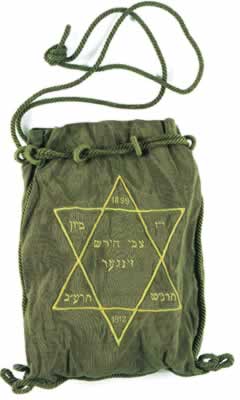|
Jewish Museum in Finchley
By Jay Levinson
It is often said about New Yorkers that they are so busy venturing afar to see interesting sites, that they never see the city where they live. The same can also be said of people in London. In the rush to travel long distances, we tend to overlook local attractions. How many Londoners have been in the Jewish Museum in Finchley?
The thrust of the main museum collection is social history. One of the topics covered, for example, is the wave of immigration from 1881 until the eve of World War I, and the problems of Jewish newcomers to England encountered. In total during this period 150,000 Jews came to England, far outnumbering those who had previously lived in the country. Many were looking to move onward to the United States (including this writer's paternal grandparents), but others found new homes, primarily in London's East End.
Chesed was a cherished value, even in the hardest of times. In 1884 Simon Cohen, a baker by trade, opened a shelter to house new immigrants. It had, of course, a "prayer room" (shul). But, the facility quickly became unsuitably small. So, the following year a larger shelter was inaugurated.
Business was of immediate concern for the London Jews. Baking is one example. As a sign of the times, bakers unions were established, first general in the 1890s, then specifically Jewish in 1909. One treasured exhibit is a 1920s banner, urging people to by bread with a union label.
It is estimated that by 1910 half of the Jewish immigrants were involved in tailoring, and one eighth dealt in the manufacture of shoes and boots. Ten percent of the immigrants were involved in furniture making. Part of the museum display is the reconstruction of a period tailoring and cabinet-making shops.
Another subject dealt with in the museum is the social history involved with World War II.
One and a half million children were put to death by the Nazis. From this dark period in history, the monument rescue efforts of the Refugee Children's Movement must not be forgotten. England agreed to accept children on condition that the effort not use government funds. Even with that stipulation, 9354 children (7482 were Jewish) were saved from the Germans and housed in some 60 hostels throughout England. The first transport was on 2 December 1938. On exhibit are pictures, tefillin, and even a suitcase used by the children.

Tephillin Bag - Courtesy of Jewish Museum, London
The number of children saved is not totally correct. As the children grew older, about one thousand of them volunteered for the British Army to fight the Nazis. Thirty of them were killed in battle.
The second storey of the museum is dedicated to the personal story of Leon Greenman. While this author toured the museum, Greenman was telling his story to a class of non-Jewish children, who listened attentively. The presentation obviously made an indelible impression on them.
Greenman was born on 18 December 1910 In Whitechapel. He married in 1935, and moved to the Netherlands. He left his British passport with friends for safekeeping, and that is when his troubles began. After the Nazi invasion in May 1940, the friends destroyed the passport, fearing that it would incriminate them as having contact with an enemy agent. Greenman could not prove his British citizenship. He was deported to Auschwitz, where his wife and child perished, then he was transported to Buchenwald.
As Greenman described the horrors of the camps to the children visiting the museum, one youngster asked if he does not blame Winston Churchill. Greenman's answer was straight-forward and to the point, "If it were not for Winston Churchill, we would not be here. He saved England!"
The Finchley Museum is open Sundays 1030-1630, Mondays-Thursdays 1030-1700. Admission: Adults £2, Students and retired £1; children 12 and younger gratis. The museum is presently located on the grounds of the Akiva School, where it is a rent-paying tenant with no affiliation with the school. Allot to the visit 90 minutes.
~~~~~~~
from the August 2006 Edition of the Jewish Magazine
|










